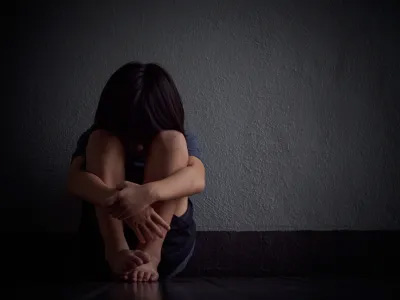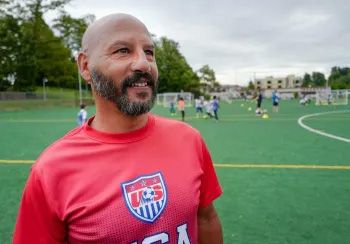Caring for Traumatized Children: A Q&A with Dr. Ben Danielson, Mark Fadool and Dr. Nat Jungbluth
April 4, 2018
 The majority of children will experience a potentially traumatic event during childhood, but only some of them will develop clinically significant distress.
The majority of children will experience a potentially traumatic event during childhood, but only some of them will develop clinically significant distress.
Identifying and supporting children who have been negatively affected by trauma is crucial to their emotional and physical health.
Primary care providers have a unique opportunity to recognize families experiencing post-traumatic stress and offer them support. We’ve brought together three experts to help: Dr. Ben Danielson, senior medical director of the Odessa Brown Children’s Clinic (OBCC); Mark Fadool, clinical director of Mental Health Services at OBCC; and Dr. Nat Jungbluth, a clinical psychologist working on a Washington state-funded pilot program to offer behavioral health services to youth and families in the Tri-Cities.
How does trauma affect a child’s health?
Dr. Danielson: The CDC-Kaiser Permanente Adverse Childhood Experiences Study, published in 1998, recognized a direct correlation between 10 stressful experiences – termed Adverse Childhood Experiences (ACEs) – and health outcomes. These experiences include: physical, verbal or sexual abuse; substance abuse by family members; parent separation or divorce; witnessing domestic violence; depression in a family; and a family member in prison, among others.
The study demonstrated that the more ACEs a person experiences during childhood, the more severe and the more frequent illnesses they are likely to suffer as a child and into adulthood.
 Dr. Ben Danielson
Dr. Ben Danielson
We see evidence of that every day at OBCC. Of all the families we treat, African-American kids have asthma two or three times more frequently and three or four times more severely than kids from other backgrounds, especially for those kids who faced more ACEs.
Interestingly, ACEs do not include poverty as a stressful event in itself. Anyone can experience a number of ACEs and have it affect their health, but poverty is an amplifier of those ACEs, and so is racism or other forms of oppression.
What are the effects of medical trauma?
Dr. Jungbluth: As providers, we don’t always recognize that trauma can occur in medical settings. Experiencing pain, being separated from caregivers, seeing an injury to their body, being exposed to frightening medical equipment, seeing other sick or injured kids or being afraid of dying can all be traumatic
Parents or caregivers also develop post-traumatic stress related to medical trauma that their kids experience. It can challenge their basic beliefs about the safety of their child and disrupt the family’s daily life.
Any trauma, when it leads to post-traumatic stress (PTS), can interfere with participation in medical care, adherence to a treatment program and overall recovery.
But there are things medical providers can do to prevent PTS or respond to it. These include effectively managing pain; providing the child and family information about what is happening and choices during medical interventions, when possible; asking about and addressing worries or fears; and checking the child’s understanding and clarifying misconceptions.
How can providers identify children who have experienced trauma?
Dr. Danielson: There are three things providers should consider. First, the ACEs questionnaire is an easy, 10-question screening tool that any provider can incorporate into their practice to understand the experiences a child has faced.
Second, it’s important for all healthcare providers to return to basics. A lot of the care that we aspire to provide cannot be done unless we first understand and address people’s basic needs. You can’t expect a family to adhere to treatment recommendations if they’re hungry all the time or don’t know where they’re going to sleep at night. By addressing these basic needs, you can build a trusting relationship with a family and create an opportunity to address past trauma.
Lastly, we owe it to our families to be steeped in an understanding of historical and intergenerational trauma, such as the effects of racism on different communities. If you don’t understand the generation-by-generation trauma that’s happened to somebody and only look at them in the moment, you’re going to miss something that their DNA has been exposed to. You don’t know what a family is carrying with them when they come to see you, and you’re doing a disservice if you don’t try to find out.
Is it feasible for pediatricians to include a trauma screening in primary care appointments?
Dr. Danielson: Providers need to consider what is most important to the families they serve. At OBCC, we believe an approach that seeks to better understand a patient’s history and needs is a better use of limited-time appointments than many of the non-evidence-based recommendations and expectations layered upon primary care practices.
What is the value in helping a child understand how their trauma affects their health and behavior?
 Mark Fadool leads a program in partnership with the Rainier Vista Boys and Girls Club to address the community’s need for mental health support by teaching soccer coaches social and emotional skills they can incorporate into training and games.
Mark Fadool leads a program in partnership with the Rainier Vista Boys and Girls Club to address the community’s need for mental health support by teaching soccer coaches social and emotional skills they can incorporate into training and games.
Fadool: Children’s responses to trauma are vastly diverse. Some want to duck and cover, while others scream and yell and throw things. It is important to create a trusting, loving, compassionate environment for families to tell their story, rather than prejudge their behavior.
Much of trauma work is being able to get the trauma out, tell the story and then slowly take control of it. Until a child can do that, the trauma will control them.
Dr. Jungbluth: Children who have experienced trauma may be concerned about why it happened or place blame on themselves or others in a way that is detrimental. They may have concerns about how the experience is going to affect their future.
But by reflecting on a trauma, they might see it differently. Sharing their experience can help them contextualize it, recognizing that it is a part of their life but it does not have to define their life. We can help them recognize that they’re not alone and that their reactions are reasonable.
How important is it to integrate mental health into primary care?
Fadool: We talk a lot about integrating mental health support into primary care so that all practitioners have the time to ask open-ended questions and hear a family’s story. But more importantly, we’ve learned that the integration of principles and concepts – having medical staff who feel comfortable talking about mental health issues – is the key to de-stigmatizing mental health and persuading families to accept a referral.
What are some of the factors that affect a child’s resilience in the face of trauma?
Dr. Danielson: Relationships and a sense of connectedness to a positive adult in a child’s life is one of the most important buffers against any kind of hardship a child might face.
In light of this, providers should spend some time making sure parents – as well as aunts, grandparents, uncles, coaches, community center managers, etc. – have the tools they need to be a positive and confident support to a child.
Dr. Jungbluth: Children can also benefit from participating in age-appropriate activities, returning to school, reconnecting with friends and general self-care.
How does a child’s trauma affect their parents? How can we involve caregivers in strengthening a family’s resiliency?
Dr. Jungbluth: Parents experience their child’s traumas very powerfully – in some cases resulting in even greater PTS than their kids have. So, we need to pay attention to how the entire family is coping when a trauma occurs.
Fadool: Sometimes, if a parent has experienced a trauma, their child will later experience the same trauma. This is often the case when a person is exposed to domestic violence.
The hard thing is, we’re asking parents to develop super skills in order to help a child who’s faced a lot of trauma. If that parent has also faced a lot of trauma, it’s a lot to ask of them.
But I see the strength in anyone who comes to the clinic and is courageous enough to share their story. It takes some work, but if you are able to uncover a family’s strengths, you can leverage that.
What should the role of primary care providers be in caring for families who have experienced trauma?
Dr. Danielson: Primary care providers can leverage well-child visits as a platform for a broader embrace of families. While these appointments can be highly structured, providers can use the time creatively to connect with broader parts of a family, integrate mental health services or connect a family to basic needs resources.
I also encourage providers to find ways to work outside their walls as pediatricians, for a few reasons:
- First, you might have some knowledge about trauma to share with teachers, WIC certifiers, community center staff and other people working with kids and families in the community.
- Second, you might learn more about your community and the kinds of trauma that kids are exposed to, even if they don’t show up on a questionnaire.
- Finally, you build trust when people see you out in the community. It shows that you care, that you’re paying attention and that you want to do a little more than the reach of your stethoscope.
How can providers reach families outside of the clinic?
 Dr. Nat Jungbluth
Dr. Nat Jungbluth
Fadool: For families who can’t make it to OBCC very often, or at all, we try to make sure they can get helpful information on their cell phone. One tool we use is the VROOM app through the Bezos Foundation. It’s a free, birth-to-three app with scientific parenting information. The misnomer we’ve heard through the years is that poor people will not access technology and don’t want to know the science behind good parenting, but that’s erroneous.
A few years ago, I started a program in partnership with the Rainier Vista Boys and Girls Club to address the community’s need for mental health support by teaching soccer coaches social and emotional skills they can incorporate into training and games.
A lot of the kids they coach would have a very difficult time coming to our clinic, so they’ve been able to reach many more people than we could in our practice.
I also lead a program called “Promoting First Relationships.” It is an evidence-based curriculum for service providers to help parents and other caregivers meet the social and emotional needs of young children. The program gives professionals who work with caregivers and young children (0 to 3) the knowledge, tools and strategies to guide and support caregivers in building nurturing and responsive relationships with children.
One lovely aspect of this program is that it is usually provided in the family’s home at a time that works for the family. This is a powerful message of how valued the family is while recognizing the amount of stress families with infants and toddlers often experience.
What advice would you offer to providers who are feeling overwhelmed by this problem?
Dr. Danielson: Aspects of medical training and indoctrination inadvertently lead to providers wanting to only hear problems for which they have clear solutions. A lot that is very understandable – we feel like we can diminish trust with our community if we hear about issues and we’re not able to help. But it is critical that providers ask questions that we don’t have the solutions for. That is how creative and innovative ideas are generated.
I have faith that a genuine desire to help and to ask questions, even when you don’t know the answers, is actually a trust-building moment, not a trust-eroding moment, in your interactions with families.
Additionally, I believe that one of the greatest reforms we need in our healthcare system is the championing of quality over quantity. We should not be focusing on the number of people we see per hour, but on the impact we can have on the people we see. And that is a time conversation. That’s a conversation about having the time to listen.
How can clinic staff members be prepared to care for children and families who have experienced trauma?
Dr. Fadool: If you’re going to have a trauma-informed program, all staff have to be informed about what that means. That means security, facility, front desk staff, MAs, DAs, everybody. Especially front desk staff, because they see so many families and have a great opportunity to make amazing impact checking a family in. At OBCC, we have found that when staff receive the tools to provide trauma-informed care, they feel much more satisfied with their position.
Local resources:
- Harborview Sexual Assault and Traumatic Stress
- Mary Bridge Child Abuse Intervention Department (Tacoma area)
- Providence Intervention Center for Assault and Abuse concurrent with Compass Mental Health (Everett area)
- King County Sexual Assault Resource Center (South King County)
Additional information on trauma impacts to health:
- Centers for Disease Control and Prevention: Information about ACEs, the original ACE Study and other resources
- ACEs Connection, a social network focused on responses to toxic stress.
- Center for the Developing Child at Harvard University
- Center for Youth Wellness, San Francisco
- “The Deepest Well: Healing the Long-Term Effects of Childhood Adversity,” by Nadine Burke-Harris
- TED Talk by Dr. Nadine Burke Harris.
- Mobilizing Action for Resilient Communities, a network of 14 sites around the country developing trauma-informed responses at the community level.